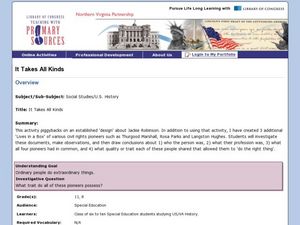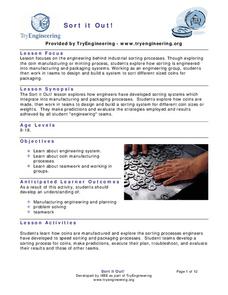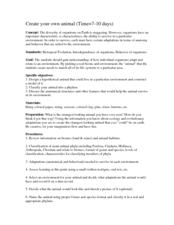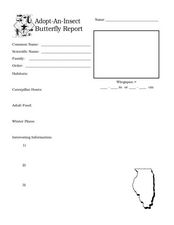Curated OER
Chemistry
In this chemistry worksheet, students classify each chemical compound as a ketone, amine, aldehyde, or ether. Students also write a condensed formula and classification for the given organic products.
Curated OER
Fossils-Where Should We Place Archaeopteryx?
Students explore an interactive computer activity that provides the opportunity to look at features of various groups of animals and determine where an extinct organism might be classified.
Curated OER
It Takes All Kinds!
Students view video clips and observe similarities and differences between animals. They sort animals into groups for a zoo. They make a graph of their observations and review scientific classifications.
Curated OER
Animal Classification
In this animal classification worksheet, students will complete a graphic organizer by writing in the different animal groups: birds, mammals, reptiles, birds, and amphibians.
Curated OER
Sort It Out
Learners study classification systems by sorting Legos and determining how the different pieces are classified. They list as many attributes as possible to use for sorting.
Curated OER
Doing Dewey
Young scholars discuss the Dewey Decimal Classification System and how it works. They organize ten books according to the Dewey Decimal Classification System.
Curated OER
Identifying Quincy's Birds
Students compare a variety or bird characteristics. They identify and classify birds within their local area. Students investigate how to examine and scrutinize differences in features of organisms and understand variation in the...
Curated OER
An Introduction to Dichotomous Keys
Young scholars pretend to be shark biologists employed by the National Oceanic and Atmospheric Administration (NOAA) who have been flown into the coastal city of Sao Luis in Brazil because locals have noticed an unidentified shark at...
Alabama Learning Exchange
The Tree of Life
Young scientists use the Internet to evaluate how organisms are classified. They research the phylogeny of organisms and how they are linked in a certain way. Pupils hone research technology skills with their final presentations.
Curated OER
Create Your Own Animal
Students design and create their own hypothetical animal. In this biology lesson, students identify the factors organisms need to survive. They classify their animals according to its correct phylum.
Curated OER
Identifying Creatures
Young scholars use a classification key from a provided worksheet to identify creatures. This task assesses student's abilities to interpret data, make decisions, identify, and classify.
Curated OER
Angle Exploration and Classification
Students compare and contrast angles and identify them as acute, obtuse, right, or straight angles. They create rays and angles using uncooked spaghetti, read and discuss key vocabulary terms, and complete a variety of geometry worksheets.
Curated OER
Primate Classification 2006
Learners examine groups of hierarchy and see how primates are categorized. In this primate classification lesson students view video and slides then examine the taxonomy of primates.
Curated OER
Invertebrate Classification
High schoolers discuss the recent disovery of the "furry lobster" to peak interest in the animal kingdom. They classify various speciments using invertebrate dichotomous keys, identifying major animal phyla and classes. Thy the complete...
Curated OER
Alien Invaders: Native vs. Exotic Species
Seventh graders investigate the differences between native and non-native species. They answer different level questions using Bloom's Taxonomy. This is done creatively with the students playing a version of the game Jeopardy. Students...
Curated OER
Where Do I Belong?
Tenth graders study the diversity of life in the world. They classify and sketch organisms into the 6 kingdoms.
Curated OER
Five Kingdoms of Living Things
Fifth graders are introduced to the classification system used in Science. In groups, they explain the characteristics of each of the five kingdoms. After watching a video, they review the life processes of each kingdom and complete a...
Curated OER
Are You One of Us?
Students investigate how scientists sort and classify organisms. In this sorting and classifying lesson, students examine what systematics are as tools that scientists use. They examine images of invertebrates and sort them while stating...
Curated OER
The Biosphere
In this biosphere worksheet, students identify the different levels of organization that ecologists study. Students complete charts, sentences, and answer short answer questions.
Curated OER
QUIZ 1A: Nouns, People, Places, Animals, and Things
In this noun classification worksheet, students 25 nouns in the provided word bank and classify them in a graphic organizer according to common and proper nouns that that name people, places, or things.
Curated OER
Sorting and Classifying
Young scholars explore organization by participating in an object sorting activity. In this classification lesson, students view a diagram which details the different ways to sort items. Young scholars practice sorting random objects in...
Curated OER
Adopt-an-Insect Butterfly Report
In this butterfly research worksheet, students complete 7 short answer categories pertaining to the life of a butterfly. This worksheet provides a visual template for the students to record facts about one butterfly species in an...
Curated OER
Identifying Vertebrates
In this biology worksheet, students look for the answers to how to classify animals. They specifically focus upon the vertebrates while differentiating the characteristics from other organisms.
Curated OER
What's the Difference?
Young scholars analyze the similarities in different species. This instructional activity is part of a multi-segmented unit on the diversity of life. In this segment, students classify shoes to mimic the scientific categories of the...

























